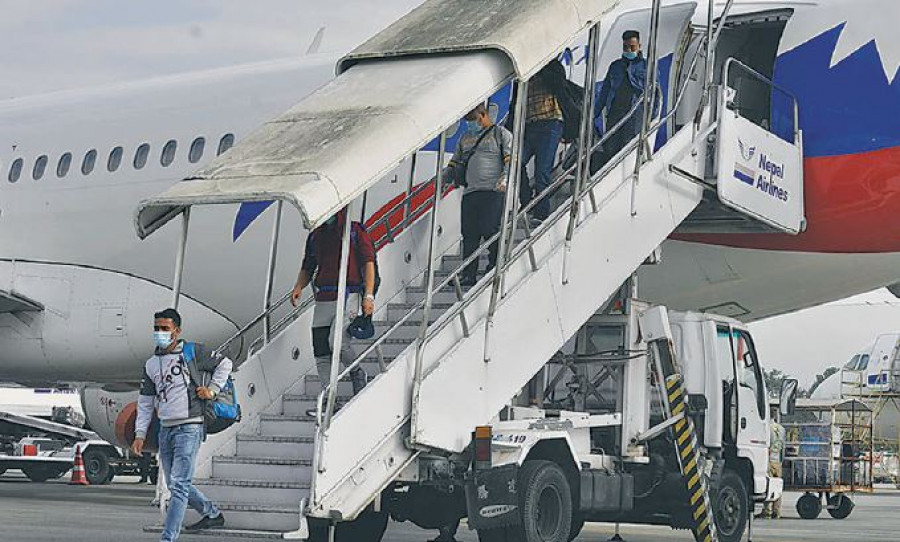National
Nearly half a million Nepalis rescued from abroad since the start of pandemic
According to the Covid-19 Crisis Management Centre, most of those rescued are from places including the Persian Gulf, Malaysia and India.
Prithvi Man Shrestha
Nearly half a million Nepalis who were stranded abroad due to the Covid-19 pandemic have been rescued so far, according to the Covid-19 Crisis Management Centre.
As per the details released by the CCMC on Friday, a total of 489,418 Nepalis from 60 countries have so far been rescued. Most people were rescued from labour destinations including the Persian Gulf states, Malaysia and India.
The highest number of Nepalis were rescued from the United Arab Emirates with 146,624 people repatriated from the country, followed by Qatar (117,408), Malaysia (51,459), Saudi Arabia (45,186), and India (39,541).
A significant number of Nepalis were also rescued from Kuwait, Turkey and Japan.
“The majority of Nepalis were rescued with the government’s own efforts and cooperation from non-resident Nepalis,” said Nurahari Khatiwada, spokesperson for the CCMC. “With so many Nepalis rescued from labour destinations, a significant number of migrant workers may have lost their jobs due to Covid-19.”
But not all Nepalis who had to be rescued from overseas were migrant workers. Khatiwada said some of them were visiting the Gulf and other countries on tourist visas. Besides, he added, individuals who were in detention centres in foreign countries were also brought home.
“The data do not cover the people who returned home under normal circumstances,” said Khatiwada.
After Covid-19 was first detected in Wuhan, China in December 2019, the government rescued 175 Nepalis from the Chinese city. The government sent a rescue flight to Wuhan in February last year to bring back the stranded Nepalis.
The government started rescuing migrant workers and other Nepalis from other countries only after a repatriation plan was introduced in June last year. As per the plan, people who were granted amnesty by foreign governments, individuals in detention centres, those whose close relatives had died at home, those who had lost their jobs, individuals with health problems other than Covid-19 and students who had completed their studies, among others, were rescued.
According to a study conducted by the National Planning Commission last year, over 255,000 Nepali migrant workers returned home from the beginning of the pandemic till the end of July 2020.
Likewise, over 75,000 aspiring overseas workers could not go to labour destinations due to the shrinking global demand.
According to the study, returnees overall numbered 366,153 from India and 37,424 from other countries by the end of July 2020. A significant number of those returnees were migrant workers.
By comparison, the number of returnees in the fiscal year 2020-21 was far lower with just 85,841 people returning home after July 31, 2020, according to the calculation based on the figures of the National Planning Commission and the latest update of the CCMC.
The commission’s study stated that with a large number of migrant workers returning from abroad, pressure has built on the domestic labour market where over 700,000 people lost their jobs due to the pandemic.
The study concluded that Nepal needed to create 2.4 million jobs in a year to accommodate all the people who had lost their jobs both at home and abroad, as well as those who were preparing to enter the labour market for the first time.
According to the Foreign Employment Promotion Board, though a large number of migrant workers returned after the Covid-19 pandemic, most of them did not require help.
“We arranged transportation and quarantine costs for Nepalis who were stranded abroad without money to return home,” said Rajan Prasad Shrestha, executive director at the board. “Their number stands between 500 and 600 only.”
The board runs various welfare schemes for migrant workers who get injured abroad and have to be brought back to the country. It also facilitates the repatriation of bodies of Nepali migrant workers who die in foreign labour destinations.
The board also runs skill training for workers who have returned home from abroad.
According to Shrestha, the board imparted skills training to around 3,400 returnee migrant workers and 27 percent of them were self-employed.
Despite the reduced number of Nepalis going abroad for employment, there has not been a significant impact on remittances.
In the fiscal year 2019-20, remittances decreased by just 0.5 percent to Rs875 billion while in the first 11 months of the last fiscal year 2020-21, remittances grew 12.6 percent to Rs871 billion, according to the central bank.
This, officials believe, may be due to the trend of sending remittances through formal channels instead of informal channels such as Hundi.




 16.12°C Kathmandu
16.12°C Kathmandu















